- europages
- >
- COMPANIES - SUPPLIERS - SERVICE PROVIDERS
- >
- machines for joints
Results for
Machines for joints - Import export

KEBA FASTENINGS
Germany
• Compatible with machine screw threads • Provides a high joint strength • Low loss of preload force under high dynamic and thermal loading • Effortless lead-in with low insertion torque for safe assembly • Excellent self-locking vibration resistance • High stripping torque • Allows for a reduction in installation depth
Request for a quote
OKS SPEZIALSCHMIERSTOFFE GMBH
Germany
For closed gear units and geared motors, plain and friction bearings even at higher rotating speeds, e.g. on filling and packaging machines For joints, propeller shafts and chains when grease lubrication is specified Advantages and benefits Toxicologically harmless as defined in German LFGB Formula in accordance the FDA guideline 21 CFR 178.3570 NSF H1 registered Long operating times due to good resistance to oxidation and ageing Reduced wear due to highly adhesive, load-bearing lubricating film Excellent corrosion protection Low dynamic viscosity enables use with minimal bearing play and gear unit spaces Good pumpability with central lubricating systems Very high resistance to hot and cold water, watery-alkaline and acidic disinfectants and cleaning agents
Request for a quote
SAMAG MACHINE TOOLS GMBH
Germany
STRONG. SOLID. LONG-TERM ACCURACY - Travelling column machining centers with modular equipment variants and particularly high performance. STABILITY, YOU CAN FEEL! - Combination of extremely rigid & stable machine - High stability during machining - Extremely high rigidity sets new standards for moving column machining centers LONG-TERM ACCURACY - Long-term machining with consistent product quality - High precision even after years of use CUSTOMIZED MACHINE SOLUTIONS - Joint development of your milling strategy - from development to commissioning - Expertise from individual to series production, also automated 24/7 - Possibility of integrated automation FLEXIBILITY THAT INSPIRES! - Wide range of options | rotary table, magnetic table, swivel table, additional magazine, partition wall, etc. - From heavy-duty machining to high-precision finishing of a wide range of materials
Request for a quote
ECKOLD TECHNICS GMBH & CO. KG
Germany
ECKOLD servo motor-driven shear clinching system for automated production. Shear clinching allows for the joining of sheet metal of high strength and soft materials (e.g. aluminium and steel). The rivet-free joining technique is a cost-effective alternative to self-piercing riveting systems. • No prehole necessary • No thermal stress at joining point • No poisonous gases or vapours • Suitable for joining metal sheets of equal and different materials and sheet thickness • Joining of sheet metal elements of varying thickness This offer includes: Servo motor-driven shear clinching system • Clinching frame incl. scrap extractor, horiz. throat of approx. 300 mm • Control cabinet incl. software ECKOLD VISU Tools are not included in the scope of delivery. They must be chosen separately, based on the actual task. Contact us for a customised offer!
Request for a quote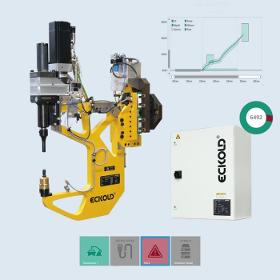
ECKOLD TECHNICS GMBH & CO. KG
Germany
To keep pace with a cost-optimised yet flexible manufacturing process, companies are on the lookout for innovative joining technologies. With its servo motor-driven clinching systems, ECKOLD offers a solution with a proven record in large-series production. Avail of the versatile ECKOLD tool range and the compact design of its machines, which allows you to reach points that were heretofore inaccessible – and make use of our efficient quality assurance and process monitoring systems. This offer includes: Servo motor-driven clinching system • Clinching frame, horiz. throat of 300 mm • Control cabinet incl. software ECKOLD VISU • Micro spray system without mounting and connecting lines • Robot-guided stroke release by customer • Tool holders (clinching type R-DF 8) Tools are not included in the scope of delivery. They must be chosen separately, based on the actual task. Contact us for a customised offer – also for special clinching types as shear clinching or CONFIX joining!
Request for a quote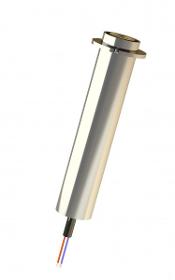
TWK-ELEKTRONIK GMBH
Germany
This encoder can be integrated inside the "Pin Joint" of heavy machinery equipment. The mounting is straightforward. This encoder is completely integrated in the joint and avoids external parts.
Request for a quote
TWK-ELEKTRONIK GMBH
Germany
The displacement transducers operate according to the principle of run time measurement between two points of a magnetostrictive waveguide. One point is determined by a moveable position magnet, whose distance from the null point corresponds to the section to be measured. The run time of an emitted impulse is directly proportionate to this section. Conversion to a measuring signal takes place in the downstream electronics. The waveguide is housed in a pressure-resistant stainless steel tube or extruded profile. To the rear of this is a die-cast aluminium housing containing the electronics in SMD technology. In the rod version, the position magnet is located in a ring, which is guided over the rod without contact. In the profile version, it is located either in a slider, which is linked to the moving part of the machine via a ball joint, or it moves as a liftable position magnet, without wear, over the profile.
Request for a quote
TWK-ELEKTRONIK GMBH
Germany
The displacement transducers operate according to the principle of run time measurement between two points of a magnetostrictive waveguide. One point is determined by a moveable position magnet, whose distance from the null point corresponds to the section to be measured. The run time of an emitted impulse is directly proportionate to this section. Conversion to an analogue measuring signal takes place in the downstream electronics. The waveguide is housed in a pressure-resistant stainless steel tube or extruded profile. To the rear of this is a die-cast aluminium housing containing the electronics in SMD technology. Electrical connection is implemented via a circular connector. In the rod version, the position magnet is located in a ring, which is guided over the rod without contact. In the profile version, it is located either in a slider, which is linked to the moving part of the machine via a ball joint, or it moves as a liftable position magnet, without wear, over the profile.
Request for a quote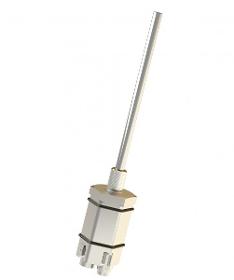
TWK-ELEKTRONIK GMBH
Germany
The displacement transducers operate according to the principle of run time measurement between two points of a magnetostrictive waveguide. One point is determined by a moveable position magnet, whose distance from the null point corresponds to the section to be measured. The run time of an emitted impulse is directly proportionate to this section. Conversion to a digital measuring signal takes place in the downstream electronics. The waveguide is housed in a pressure-resistant stainless steel tube or extruded profile. To the rear of this is a die-cast aluminium housing containing the electronics in SMD technology. In the rod version, the position magnet is located in a ring, which is guided over the rod without contact. In the profile version, it is located either in a slider, which is linked to the moving part of the machine via a ball joint, or it moves as a liftable position magnet, without wear, over the profile.
Request for a quote
TWK-ELEKTRONIK GMBH
Germany
The displacement transducers operate according to the principle of run time measurement between two points of a magnetostrictive waveguide. One point is determined by a moveable position magnet, whose distance from the null point corresponds to the section to be measured. The run time of an emitted impulse is directly proportionate to this section. Conversion to an analogue measuring signal takes place in the downstream electronics. The waveguide is housed in an extruded aluminium profile. The electronics is housed in a die-cast aluminium sensor head. Electrical connection is implemented via a circular connector. The position magnet is located either in a slider, which is linked to the moving part of the machine via a ball joint, or it moves as a liftable position magnet, without wear, over the profile.
Request for a quote
TWK-ELEKTRONIK GMBH
Germany
The displacement transducers operate according to the principle of run time measurement between two points of a magnetostrictive waveguide. One point is determined by a moveable position magnet, whose distance from the null point corresponds to the section to be measured. The run time of an emitted impulse is directly proportionate to this section. Conversion to a digital measuring signal takes place in the downstream electronics. The waveguide is housed in a pressure-resistant stainless steel tube or extruded profile. To the rear of this is a die-cast aluminium housing containing the electronics in SMD technology. In the rod version, the position magnet is located in a ring, which is guided over the rod without contact. In the profile version, it is located either in a slider, which is linked to the moving part of the machine via a ball joint, or it moves as a liftable position magnet, without wear, over the profile.
Request for a quote
TWK-ELEKTRONIK GMBH
Germany
The displacement transducers operate according to the principle of run time measurement between two points of a magnetostrictive waveguide. One point is determined by a moveable position ring, whose distance from the null point corresponds to the section to be measured. The run time of an emitted impulse is directly proportionate to this section. Conversion to a displacement signal takes place in the downstream electronics. The waveguide is housed in a pressure-resistant stainless steel tube or extruded profile. To the rear of this is a die-cast aluminium housing containing the electronics in SMD technology. In the rod version, the position magnet is located in a ring, which is guided over the rod without contact. In the profile version, it is located either in a slider, which is linked to the moving part of the machine via a ball joint, or it moves as a liftable position magnet, without wear, over the profile.
Request for a quote
TWK-ELEKTRONIK GMBH
Germany
The displacement transducers operate according to the principle of run time measurement between two points of a magnetostrictive waveguide. One point is determined by a moveable position magnet, whose distance from the null point corresponds to the section to be measured. The run time of an emitted impulse is directly proportionate to this section. Conversion to an analogue measuring signal takes place in the downstream electronics. The waveguide is housed in a pressure-resistant stainless steel tube or extruded profile. To the rear of this is a die-cast aluminium housing containing the electronics in SMD technology. Electrical connection is implemented via a circular connector. In the rod version, the position magnet is located in a ring, which is guided over the rod without contact. In the profile version, it is located either in a slider, which is linked to the moving part of the machine via a ball joint, or it moves as a liftable position magnet, without wear, over the profile.
Request for a quote
TWK-ELEKTRONIK GMBH
Germany
The displacement transducers operate according to the principle of run time measurement between two points of a magnetostrictive waveguide. One point is determined by a moveable position magnet, whose distance from the null point corresponds to the section to be measured. The run time of an emitted impulse is directly proportionate to this section. Conversion to a measuring signal takes place in the downstream electronics. The waveguide is housed in a pressure-resistant stainless steel tube or extruded profile. To the rear of this is a die-cast aluminium housing containing the electronics in SMD technology. In the rod version, the position magnet is located in a ring, which is guided over the rod without contact. In the profile version, it is located either in a slider, which is linked to the moving part of the machine via a ball joint, or it moves as a liftable position magnet, without wear, over the profile.
Request for a quote
TWK-ELEKTRONIK GMBH
Germany
The displacement transducers operate according to the principle of run time measurement between two points of a magnetostrictive waveguide. One point is determined by a moveable position magnet, whose distance from the null point corresponds to the section to be measured. The run time of an emitted impulse is directly proportionate to this section. Conversion to a digital measuring signal takes place in the downstream electronics. The waveguide is housed in a pressure-resistant stainless steel tube or extruded profile. To the rear of this is a die-cast aluminium housing containing the electronics in SMD technology. Electrical connection is implemented via a circular connector. In the rod version, the position magnet is located in a ring, which is guided over the rod without contact. In the profile version, it is located either in a slider, which is linked to the moving part of the machine via a ball joint, or it moves as a liftable position magnet, without wear, over the profile
Request for a quote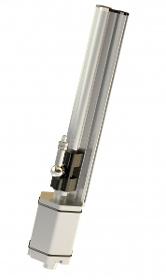
TWK-ELEKTRONIK GMBH
Germany
The displacement transducers operate according to the principle of run time measurement between two points of a magnetostrictive waveguide. One point is determined by a moveable position magnet, whose distance from the null point corresponds to the section to be measured. The run time of an emitted impulse is directly proportionate to this section. Conversion to a digital measuring signal takes place in the downstream electronics. The waveguide is housed in a pressure-resistant stainless steel tube or extruded profile. To the rear of this is a die-cast aluminium housing containing the electronics in SMD technology. Electrical connection is implemented via a circular connector. In the rod version, the position magnet is located in a ring, which is guided over the rod without contact. In the profile version, it is located either in a slider, which is linked to the moving part of the machine via a ball joint, or it moves as a liftable position magnet, without wear, over the profile.
Request for a quote
TWK-ELEKTRONIK GMBH
Germany
The displacement transducers operate according to the principle of run time measurement between two points of a magnetostrictive waveguide. One point is determined by a moveable position ring, whose distance from the null point corresponds to the section to be measured. The run time of an emitted impulse is directly proportionate to this section. Conversion to a displacement signal takes place in the downstream electronics. The waveguide is housed in a pressure-resistant stainless steel tube or extruded profile. To the rear of this is a die-cast aluminium housing containing the electronics in SMD technology. In the rod version, the position magnet is located in a ring, which is guided over the rod without contact. In the profile version, it is located either in a slider, which is linked to the moving part of the machine via a ball joint, or it moves as a liftable position magnet, without wear, over the profile.
Request for a quoteDo you sell or make similar products?
Sign up to europages and have your products listed
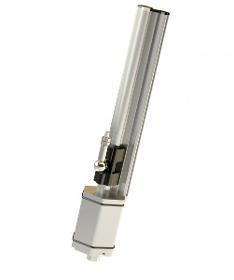
TWK-ELEKTRONIK GMBH
Germany
The displacement transducers operate according to the principle of run time measurement between two points of a magnetostrictive waveguide. One point is determined by a moveable position magnet, whose distance from the null point corresponds to the section to be measured. The run time of an emitted impulse is directly proportionate to this section. Conversion to an analogue measuring signal takes place in the downstream electronics. The waveguide is housed in a pressure-resistant stainless steel tube or extruded profile. To the rear of this is a die-cast aluminium housing containing the electronics in SMD technology. Electrical connection is implemented via a circular connector. In the rod version, the position magnet is located in a ring, which is guided over the rod without contact. In the profile version, it is located either in a slider, which is linked to the moving part of the machine via a ball joint, or it moves as a liftable position magnet, without wear, over the profile.
Request for a quoteResults for
Machines for joints - Import exportNumber of results
19 ProductsCountries
Company type